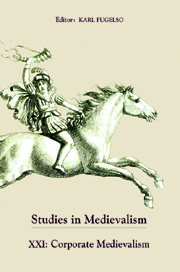Book contents
- Frontmatter
- Acknowledgments
- Contents
- Title in the Series
- Editorial Note
- I Corporate Medievalism: Some Perspective(s)
- II Interpretations
- Historicizing Neumatic Notation: Medieval Neumes as Cultural Artifacts of Early Modern Times
- Hereward the Dane and the English, But Not the Saxon: Kingsley's Racial Anglo-Saxonism
- From Romance to Ritual: Jessie L. Weston's Gawain
- The Cinematic Sign of the Grail
- Destructive Dominae: Women and Vengeance in Medievalist Films
- III Response
- Notes on Contributors
- Title in the Series
Historicizing Neumatic Notation: Medieval Neumes as Cultural Artifacts of Early Modern Times
from II - Interpretations
Published online by Cambridge University Press: 05 February 2013
- Frontmatter
- Acknowledgments
- Contents
- Title in the Series
- Editorial Note
- I Corporate Medievalism: Some Perspective(s)
- II Interpretations
- Historicizing Neumatic Notation: Medieval Neumes as Cultural Artifacts of Early Modern Times
- Hereward the Dane and the English, But Not the Saxon: Kingsley's Racial Anglo-Saxonism
- From Romance to Ritual: Jessie L. Weston's Gawain
- The Cinematic Sign of the Grail
- Destructive Dominae: Women and Vengeance in Medievalist Films
- III Response
- Notes on Contributors
- Title in the Series
Summary
If one of the major tasks of studying medievalism is to provide a basis for the self-critique of modern disciplines dealing with (what they construe as) medieval objects, then medieval musicology constitutes a very promising, and little explored, field of observation. This article will present the results of a study devoted to one of the most fundamental branches of the discipline since its inception: the paleography of early medieval notation. It will do so by moving back to the vast pre-history of the musicological discourse on notation, starting in the sixteenth century and following discursive transformations up to the late nineteenth century.
When medieval musicology was taking shape in the later nineteenth century and its pioneers outlined an approach to neumes, which are the earliest practical medieval notation, they realized that they were not the first to study them. They even made an inventory of their predecessors. However, the very idea of considering these older writers as predecessors meant that the later nineteenth-century musicologists envisaged the discourses with which they were dealing as primitive and very unsuccessful attempts at doing that which they believed only they themselves were managing to accomplish.
As an attempt to counter this problematic approach and to initiate the exploration of the rich corpus of earlier writers who touched upon what we now call neumes, the present article will examine the same sources from a point of view that is, in Foucault's sense of the term, primarily archaeological.
- Type
- Chapter
- Information
- Studies in Medievalism XXICorporate Medievalism, pp. 65 - 88Publisher: Boydell & BrewerPrint publication year: 2012



